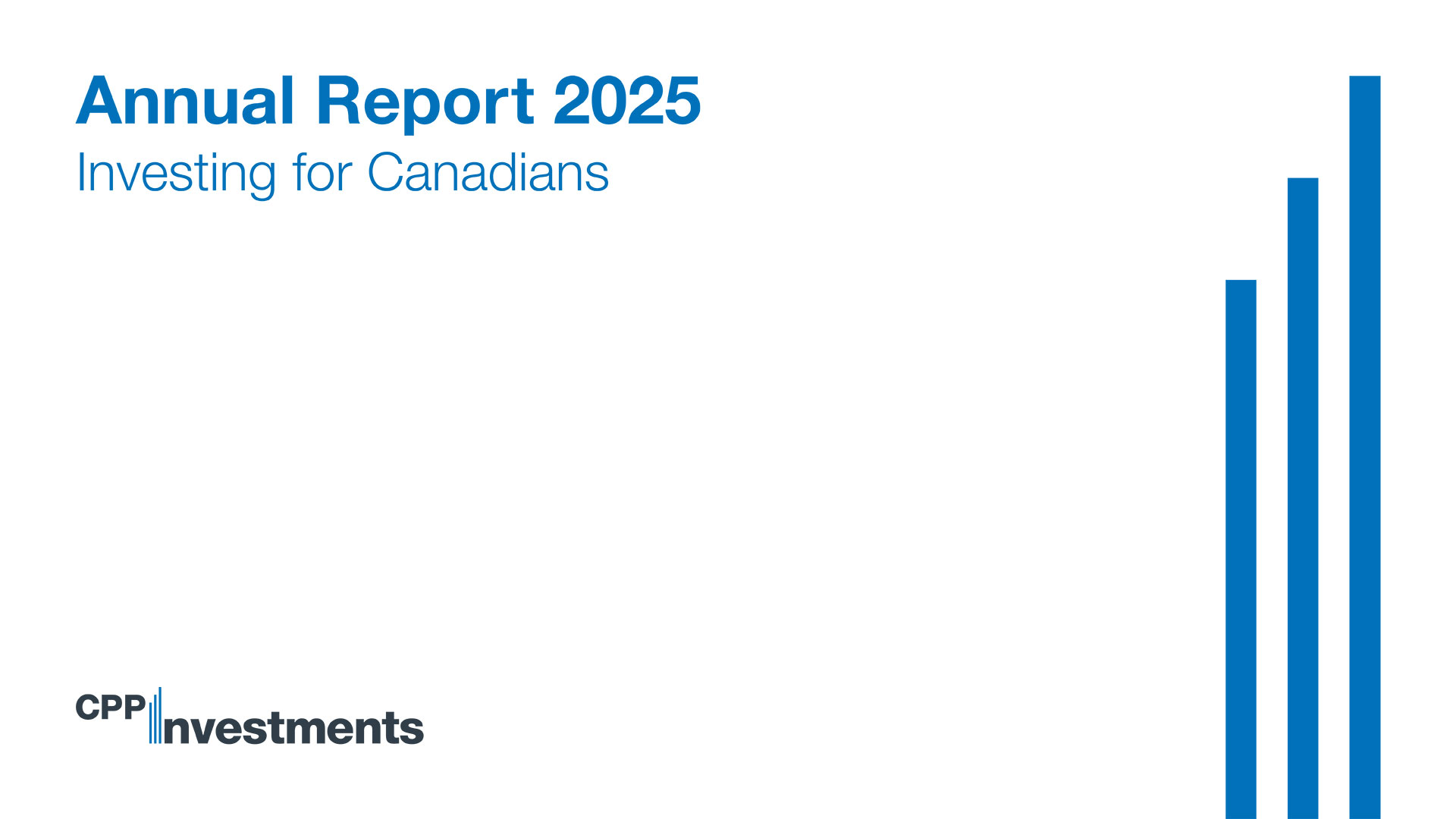Our investment strategy is designed to deliver a well-balanced and globally diversified portfolio that will maximize sustained long-term returns without incurring undue risk.
The portfolio is structured to be resilient in the face of wide-ranging market and economic conditions. It covers all major asset classes, manages and mitigates significant risk factors, and encompasses multiple distinct investment strategies.
With this approach we’re able to achieve an effective balance of risks and returns while seeking to add significant value through active management. Our goal is to achieve sustainable returns over the long term in the best interests of the contributors and beneficiaries of the Canada Pension Plan (CPP).
In structuring the portfolio, we:
- maintain a long-term view;
- take on an appropriate amount of risk to benefit from global economic growth and other return generators;
- choose investment strategies and asset types with distinct underlying drivers of return and risk;
- avoid being overly dependent on returns in any one country, currency or region;
- invest strategically as economic and market conditions change; and
- utilize the specialist talents of experienced investment professionals from around the world.
Our approach is based on a carefully designed investment framework, the active management of the portfolio by our skilled internal and external portfolio managers and a disciplined total portfolio view.
We employ a total portfolio investment framework with diverse exposures to the broad capital markets to help sustain the CPP. We also generate incremental returns through active management that are above what could be achieved through a passive investment strategy.
CPP Investments has eight investment beliefs, which are foundational judgments that provide a compass as we navigate global capital markets to carry out our mandate. They provide clarity and consistency in the decisions we make and help us stay the course as a long-term investor. Additional detail can be found on Our Investment Beliefs.
Our Reference Portfolio, Strategic Portfolio, Target Exposures and Annual Target Portfolio are the key elements of the overall investment framework that organizes our investment decision-making. Each one plays an important role in helping us to:
- build and develop an optimal portfolio of assets and investment strategies within a well-defined overall risk target; and
- continuously re-balance the return-risk exposures in the actual Investment Portfolio within an established set of parameters.
Reference portfolio
A certain minimum level of investment risk must be taken for expected long-term returns to be sufficient to sustain the CPP. We start with defining our risk appetite, the level of risk above the minimum that we believe will most optimally sustain the plan, balancing higher long-term expected returns against increased short-term volatility.
It is through the Board-approved Reference Portfolio that we express this risk target. The Reference Portfolio is a globally diversified two-index portfolio of publicly traded securities that could be invested in passively, at low cost. As such it also serves to form the risk-equivalent benchmark for the net returns we achieve in the actual Investment Portfolio. The Reference Portfolio for the base CPP is 85% global equity and 15% Canadian governments bonds. For the additional CPP, which carries greater sensitivity to shortfalls in investment returns, the Reference Portfolio is 55% global equity and 45% Canadian governments bonds.
We review the Reference Portfolios every three years following the release of the triennial Actuarial Report on the Canada Pension Plan by the Office of the Chief Actuary.
Strategic portfolio
The Strategic Portfolio lays out our aspirational plan for diversifying the Investment Portfolio over the next five years and beyond. We build the Strategic Portfolio by optimizing the underlying exposures to long-term risks and returns in the portfolio. It reflects the mix of six distinct asset classes and three geographic regions that we believe will deliver superior resilience to market downturns and higher long-term returns than the Reference Portfolio. It carries the same total absolute risk as the Reference Portfolio.
We review and adjust this portfolio every three years at the same time as we review the Reference Portfolio.
Target exposures
The Target Exposures define the targeted composition of risk-return factor exposures and leverage of the Investment Portfolio for the current year, driving our current portfolio towards the long-term composition for which we’re aiming. It is constructed within Board-authorized bands of asset class and geographic weights, and subject to maintenance of sufficient liquidity in the total portfolio to:
- meet all CPP Investments obligations as they come due;
- permit rebalancing of the portfolio when necessary; and
- fund new investments.
With the relative weighting of asset classes and risk exposures of the actual Investment Portfolio fluctuating on a day-to-day basis, we use the Target Exposures to guide the rebalancing of the Investment Portfolio so that it remains in line with our factor exposure and geographic targets, and close to the overall targeted risk.
Our investment strategy is designed to deliver a well-balanced and globally-diversified portfolio that will maximize sustained long-term returns without incurring undue risk.
Our role is to invest the funds of the Canada Pension Plan (CPP) to help ensure that it can provide benefits to Canadians over many generations. Because we don’t have to sell investments to meet our obligations and because we have a reliable income stream due to ongoing contributions, we can look beyond regular economic cycles when making our investment decisions. This ability to look well beyond the short term – one of our comparative advantages – means that we can benefit from opportunities in ways others can’t. We can take advantage of short-term market dynamics and hold assets whose rewards may take longer to emerge.
Accepting volatility
In contrast to most pension plans that have short-term obligations or funding requirements, the sustainability of the CPP Fund is less vulnerable to volatility of both asset prices and current returns. Our long horizon and certainty of assets mean that we can prudently tolerate and absorb short-term changes in investment values and look through market cycles.
The advantage of this is that, over the longer term, the benefit of higher returns progressively outweighs the impact of higher short-term volatility. So we can be patient, flexible investors who can take a higher level of long-term risk while also benefiting from volatility by capturing opportunities that arise during market downturns.
Embracing risk
Risks and returns are tradeoffs. The more risk one is willing to accept, the higher the potential return as long as that risk is priced and evaluated properly. We can prudently and carefully take on risk in the short term in our asset mix, our strategies and our major investments and in turn increase the potential long-term returns. By embracing compensated risk for higher returns we can build a portfolio that supports the CPP and its members and beneficiaries over the long term.
Base and additional Canada Pension Plan
In 2016, the federal and provincial governments expanded the CPP beyond the “base CPP” by creating the “additional CPP,” which is designed to provide greater retirement and other benefits for contributors. The changes, also known as the “CPP enhancement,” were first applied to contributions made in January 2019.
This means the CPP will provide a growing portion of contributors’ retirement income in the future, providing greater financial stability to retired Canadians. The maximum level of annual CPP retirement benefits for an individual who has made 40 years of contributions to the additional CPP will rise from 25% to 33% of pensionable earnings.
To pay for this increase in benefits, governments raised both the contributions required on earnings covered by the CPP and the upper limit on the amount of a contributor’s earnings that are covered, also known as the earnings ceiling. These two increases are being phased in over seven years. In return, the CPP will be able to provide larger benefits over time.
Since 2019, the CPP Fund has had two parts:
- “Base CPP,” which refers to the benefits and contributions continuing at the rates used before January 2019; and
- “Additional CPP,” which refers to the additional benefits and contributions that started in January 2019.
Both the base CPP and the additional CPP receive the full advantages of the long-term investing strategies and capabilities of CPP Investments, provided through our global network, expertise and risk governance framework, with the assets of each part being invested at their own distinct investment risk profiles.
Additional contributions to support greater benefits
Starting in 2024, the CPP now has two components:
- An increased contribution rate up to 5.95% was phased in from 2019 to 2023 on earnings up to the Year’s Maximum Pensionable Earnings (YMPE), or the first earnings ceiling. The additional 1% contribution rate is for both employee and employer.
- A new, second earnings ceiling was introduced in 2024 and includes a 4% contribution rate on earnings above the YMPE known as the Year’s Additional Maximum Pensionable Earnings (YAMPE). The YAMPE, also known as CPP2, will be introduced over two years – 2024 and 2025.
By 2025, the maximum employment earnings amount covered by the CPP will have risen by 14% above the base YMPE, up to the second earnings ceiling, or YAMPE. Following 2025, annual adjustments to both YMPE and YAMPE will continue at the rate of growth in Canadian average weekly earnings in the Industrial Composite, as published by Statistics Canada, while contribution rates will remain the same indefinitely.
Enhancing the CPP with these additional elements will mean more retirement stability for future Canadian retirees through up to 50% higher benefits.
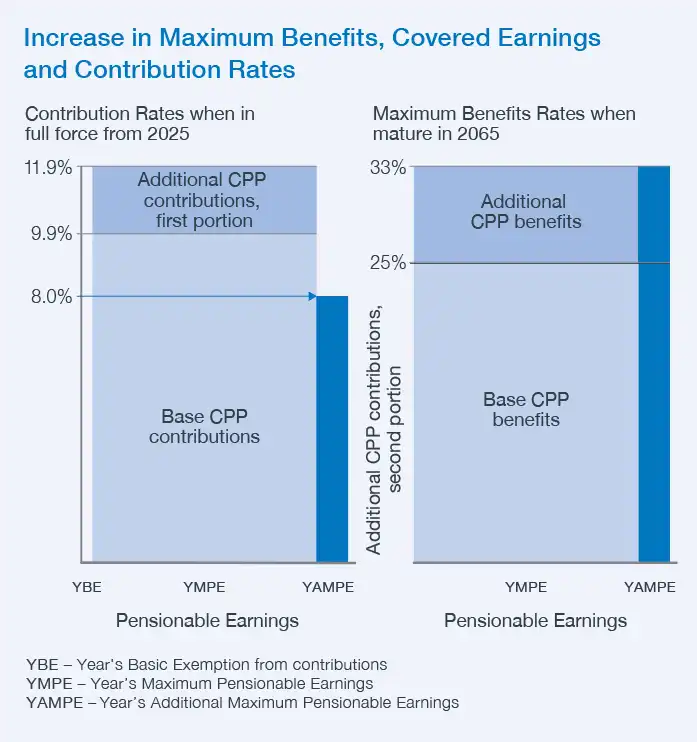
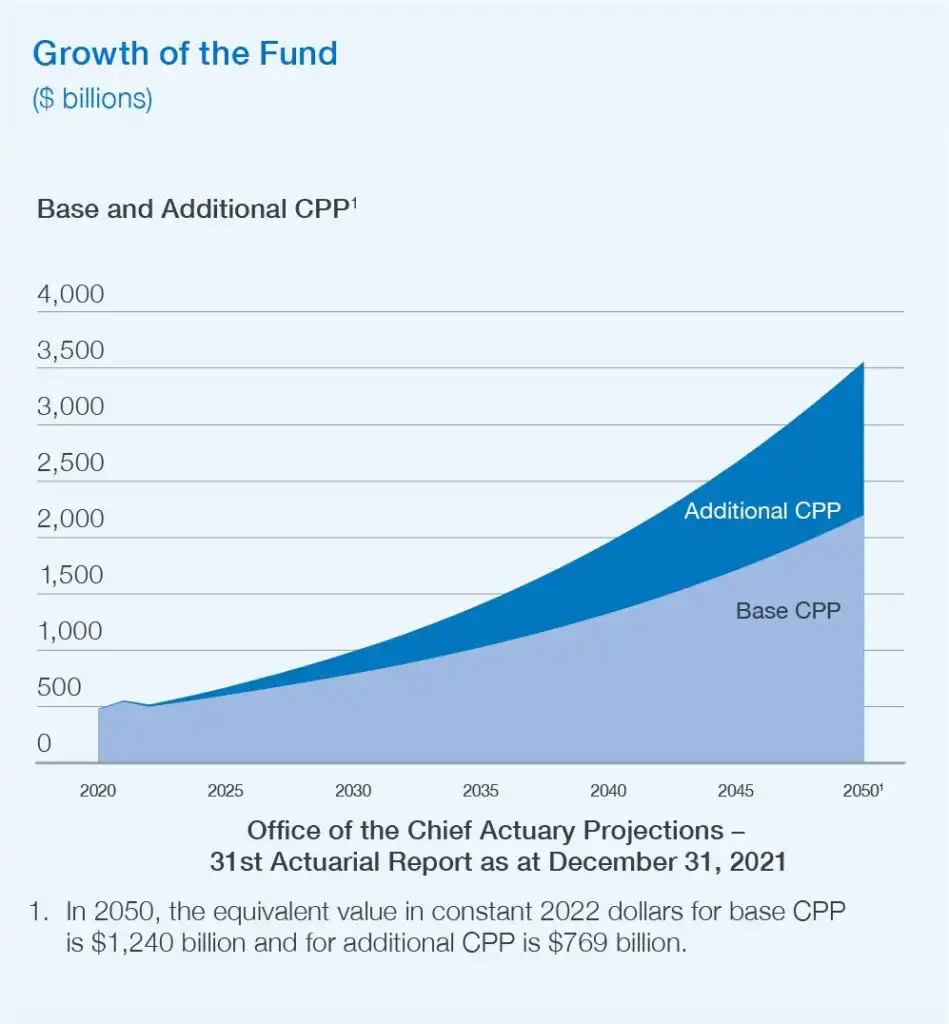
Two sources of growth
Separate accounts are maintained for the base CPP and the additional CPP. Both have two sources of growth: cash inflows from the CPP when contributions exceed benefits, and net investment income.
The base CPP account is expected to continue to grow as net investment income is projected to exceed the annual net CPP outflows that are needed for benefit payments in excess of contributions.
For the additional CPP, contributions are projected to exceed benefit payments until at least 2057. As a result, assets in the additional CPP account will grow at a much faster rate than those in the base CPP account.
For the partially‑funded base CPP, the percentage of total revenues from investment income is expected to grow slowly, from 32% in 2023 to 48% in 2080. However, for the fully‑funded additional CPP, investment income will grow rapidly as a percentage of total revenues, from 9% in 2023 to about 72% of its total revenues by 2080.
The next actuarial review will be performed in 2025 and will cover the status of both base and additional CPP as at December 31, 2024.
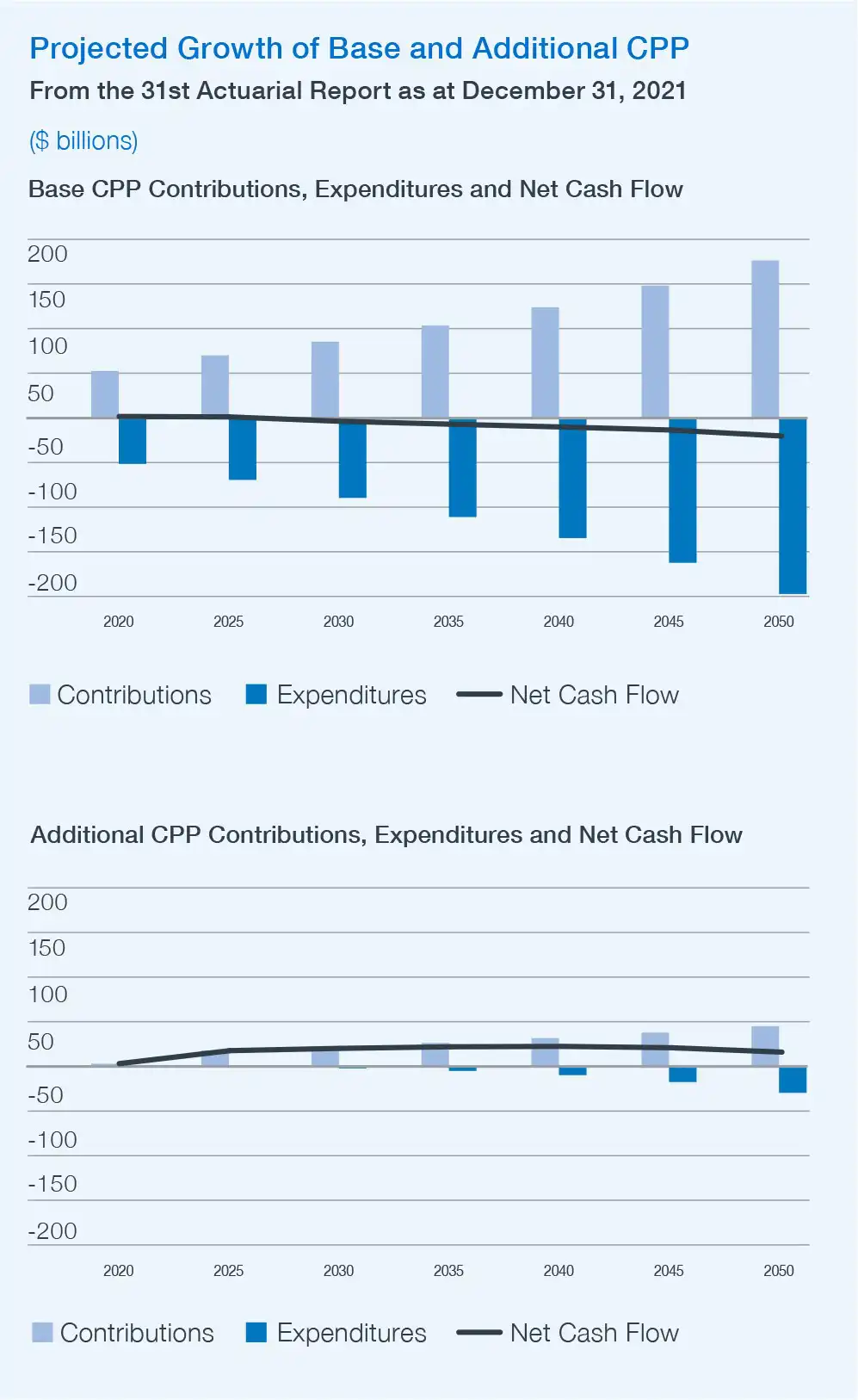
Two-account, two-pool investment structure
To enable the base CPP and additional CPP accounts to have appropriately different overall market risk levels, we maintain two investment pools, each divided into units that are valued daily. Each of the base CPP and additional CPP accounts invest their long-term investment portfolios through holdings of these units as follows:
- The base CPP investment portfolio is entirely allocated to the “Core pool”. This pool is broadly diversified across asset classes, geographies and management strategies. It is managed to the risk level appropriate for the base CPP. Also, a substantial proportion of additional CPP cash inflows (60% to 65% in fiscal 2022) are allocated to the Core pool.
- To maintain the lower-risk target of the additional CPP, the remaining assets in its investment portfolio are invested in the lower-risk “Supplementary pool”. This pool presently consists entirely of fixed-income securities. When the Supplementary pool is combined in the right proportion with the additional CPP account’s investments in the Core pool, the resulting overall risk and the underlying market and currency exposures are appropriate for the additional CPP.
- Because returns in the Core and Supplementary pools will differ, the proportions of the two pools held by the additional CPP account will change over time. We rebalance the proportions primarily by adjusting how much of the weekly incoming cash flow from the additional CPP goes into each pool.
The two-pool structure enables CPP Investments to allocate all opportunities, individual investments and investment programs equitably, constantly and effectively between the base and additional CPP accounts. The structure respects and enables the distinct risk targets of the base and additional CPP investment portfolios. It also avoids the significant costs and complexity that would be associated with managing each account separately.
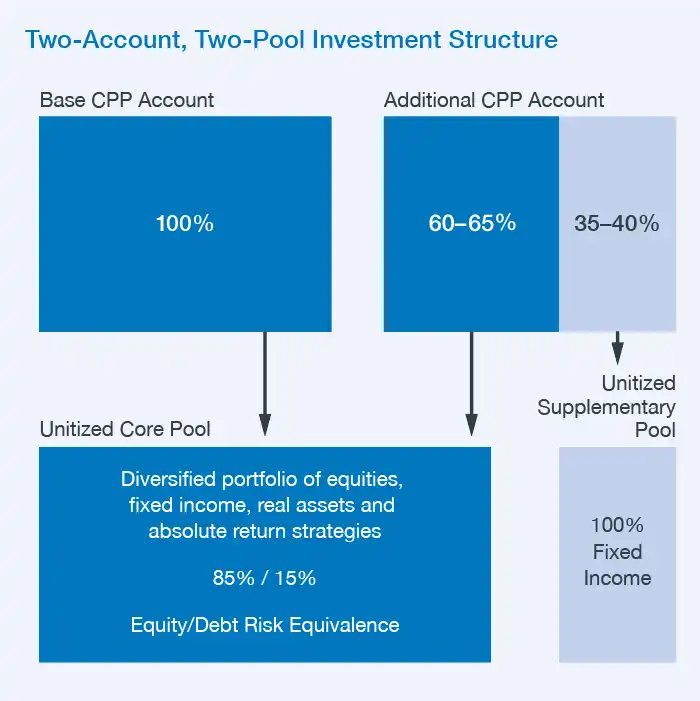
Allocation of costs between the base CPP and the additional CPP
CPP Investments allocates costs to the base CPP and the additional CPP based on the proportion of their holdings in the two pools, ensuring costs are shared on a fair and consistent basis. For more details on the actual costs allocated to each account in fiscal 2023, see Note 18.4 of the Financial Statements on page 133 of the 2023 Annual Report.
The Sources of Returns and Value Added
CPP benefits are sustained by only two revenue streams – contributions by participants and net returns on investments. Long-term returns arise from the markets in which we invest, and the value we add by our active decisions.
First, we recognize that there is a minimum level of market risk that must be taken to generate expected returns sufficient to sustain the CPP. We assess this minimum required level of market risk as a mix of 50% global public equities and 50% Canadian government bonds for the base CPP. For the additional CPP, we assess it as 40% global public equities and 60% Canadian government bonds.
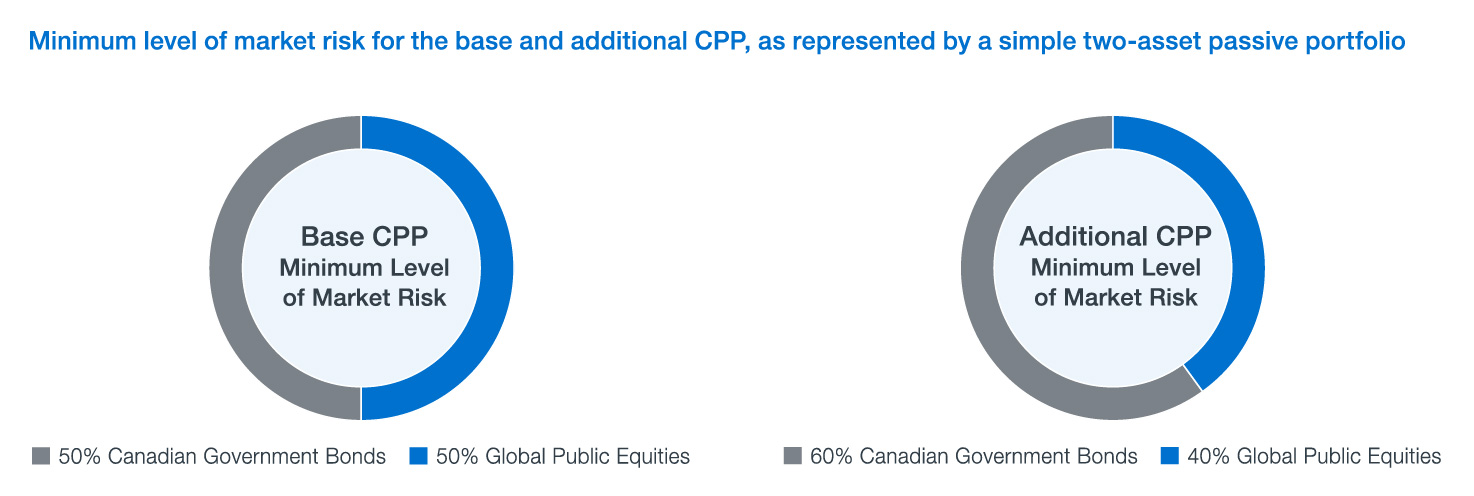
However, we do believe that investing to generate only minimum returns is not consistent with our legislative mandate, which is to maximize returns without undue risk of loss. So, we actively manage the Fund and pursue additional sources of value-add returns.
We view active management as a spectrum of potential choices that we can make to generate additional returns.
First, we target a higher level of market risk, and then construct a broadly diversified multi-asset class portfolio, enabled by leverage. We consider these to be active investment decisions, and our choices in respect of market risk levels, leverage and asset class diversification all have major impacts on the investment performance of the Fund. Further, we dedicate much of our investment talent to actively selecting individual investments and managing the composition of their portfolios. Investment selection carries the widest range of opportunities for skilled, value-conscious investors to generated incremental returns, and provides the greatest scope for deploying our comparative advantages.
Diversification and leverage
We hold significant investments around the world in all the main asset classes, each with their own associated return-risk exposures. Our diversified portfolio is invested in public markets (principally public companies and government bonds), private companies (both equity and debt), and real assets such as real estate, infrastructure, and sustainable energy. The use of leverage (borrowings through the issue of debt securities and the use of derivatives) not only increases the size of our invested asset base but also permits more optimal diversification at our market risk target.
Investment selection
Our internal and external managers use a variety of strategies for buying, weighting and selling individual investments – and seek to generate value in both rising and falling markets. The result is that:
- We can profit from buying undervalued and selling overvalued public securities.
- We can participate in some of the largest private transactions and opportunities in the world, through funds, co-investments and direct ownership.
- We can manage the pace of participation in private investments, both equity and debt, through disciplined evaluation and relative value judgements rather than being driven by a commercial need to invest in a particular sector or strategy.
- We can reflect in our decisions the impacts, risk and opportunities of climate change on specific companies and investments.
- We can act as engaged and active owners of direct equity, real estate and infrastructure investments, as well as through our long-term holdings in many public companies, to promote enhanced governance, environmental, social and operational corporate practices.
We periodically adjust our portfolio to reflect shorter- or mid-term market opportunities or investment views, to enhance returns or preserve capital.
Setting targets for active and balancing strategies
Our investment portfolios are composed of active and balancing portfolios. We have active strategies in both private and public markets across five investment departments – Capital Markets and Factor Investing, Active Equities, Credit Investments, Private Equity and Real Assets.
Together, these make up our active portfolio, which along with the assets in our balancing portfolios maintain our targeted set of diversified exposures. Balancing strategies within the balancing portfolio are generally invested in liquid, publicly traded securities. Together, the active and balancing portfolios deliver the targeted factor, asset class, geographic, currency and sector diversification of each of the investment portfolios.
Our active strategies seek to identify opportunities in which internal or external specialists can deliver incremental value-add returns through investment selection. Annually, the Chief Investment Officer (CIO) reviews the mandate and performance of each investment strategy to refresh the Fund’s capital allocations.
This process is informed by our annual investment department reviews, which evaluate all strategies across a number of key dimensions, including their investment performance, value add, risk profile, cost efficiency, exposure delivery and capital efficiency. The CIO uses the learnings from these reviews to update the targeted weight of each strategy in the context of the Fund. In turn, this translates into the capital budget and expected growth trajectory of our strategies.
Our investment strategy is designed to deliver a well-balanced and globally-diversified portfolio that will maximize sustained long-term returns without incurring undue risk.
Diversification is our most powerful lever for ensuring the long-term resilience of our portfolio and is our main tool for managing overall risk. We diversify in four ways:
- Asset diversification: We invest across all major asset classes, including public equities, private equities, fixed income, credit, real estate and infrastructure.
- Risk diversification: We balance and manage exposures to the distinct return-risk factors underlying areas of investment and active management.
- Geographic diversification: By investing in developed and emerging countries, we avoid relying too heavily on growth in any single market and reduce dependence on the Canadian economy. Our global, on-the-ground presence established through our global offices strengthens our ability to achieve broad global diversification and manage assets we own locally.
- Strategic diversification: Our portfolio is a balanced collection of coordinated strategies that together form a coherent whole. Approaching investment decisions through a broad range of expertise and views lets the Fund take advantage of opportunities from diverse investment perspectives. We bring a “One Fund” mindset to sharing our knowledge and insights across all our groups, and to applying the full weight of our assets and collective capabilities in accessing the best investment opportunities across the world.
Each year, we review our strategic mix of key return risk factor exposures and leverage. These strategic exposures are tailored to meet the Fund’s long-term objectives at our targeted level of market risk.
We translate our strategic exposures into weightings of several distinct public and private asset classes. These strategic portfolios represent indicative asset allocations in five years’ time and beyond. They also convey our long-term expectations for allocating assets into three geographic regions: Canada, developed markets excluding Canada and emerging markets.
The result is a broadly diversified, aspirational portfolio, which has higher expected returns at our targeted level of market risk and greater expected resilience to extreme downturns.
The use of leverage also allows us to add other asset classes with more stable and growing income streams such as credit, real estate, infrastructure and other real assets. These generally carry a lower level of market risk and corresponding returns than the public equities in the reference portfolios. They also allow us to pursue a wider variety of higher risk and higher return strategies, such as:
- replacing allocations to publicly traded companies with privately held ones;
- substituting government bonds with higher-yielding credits in public and private debt;
- using debt to help finance our real estate and infrastructure investments;
- increasing participation in select emerging markets; and
- making use of long-short investment strategies that add value through investment selection.
Our view on foreign currency
Another aspect of diversification is the selection of investments priced in foreign currencies.
Changes in foreign exchange rates on our non-Canadian dollar investments have a substantial impact on short-term investment performance expressed in Canadian dollars. We do not manage this risk with currency hedging for four reasons:
- Hedging foreign equity returns tends to increase, rather than reduce, overall return volatility for a Canadian global investor. The Canadian dollar tends to strengthen when global equity markets are rising and weaken when they are falling. This is partly due to the Canadian dollar’s status as a commodity currency. We believe the Canadian dollar will continue to behave in this way.
- When the Canadian dollar strengthens against other currencies as a result of higher commodity prices, especially oil, the Canadian economy is also likely to be stronger. This in turn should lead to increased aggregate earnings for CPP contributors. As earnings rise, so will contributions into the Fund. Accordingly, this represents a natural hedge for us and reduces the need for explicit currency hedging of the Fund’s foreign investments.
- The cost of hedging currencies is especially high in emerging markets. However, if these countries continue to experience higher productivity and economic growth as their economies mature, their currencies should tend to strengthen over time. That would make a hedging program a long-term drag on returns.
- We can mitigate the volatility of individual exchange rates by holding a broadly diversified set of currency exposures across the world.
Accordingly, we generally do not hedge foreign currency exposures but may do so selectively where appropriate. In the short term, the decision not to hedge currency can impact Fund returns in either direction. In years of major strengthening or weakening of the Canadian dollar, the performance of the Fund may differ materially from other funds that have a standing hedging policy.
We call our decision-making process the Total Portfolio Approach. It encompasses our portfolio construction and capital allocation, deployment and management activities.
We strive to manage a variety of risks, while maximizing investment returns from all sources:
- market risk appetite;
- diversification and leverage;
- investment selection; and
- tactical positioning.
Stages in the Total Portfolio Investment Framework
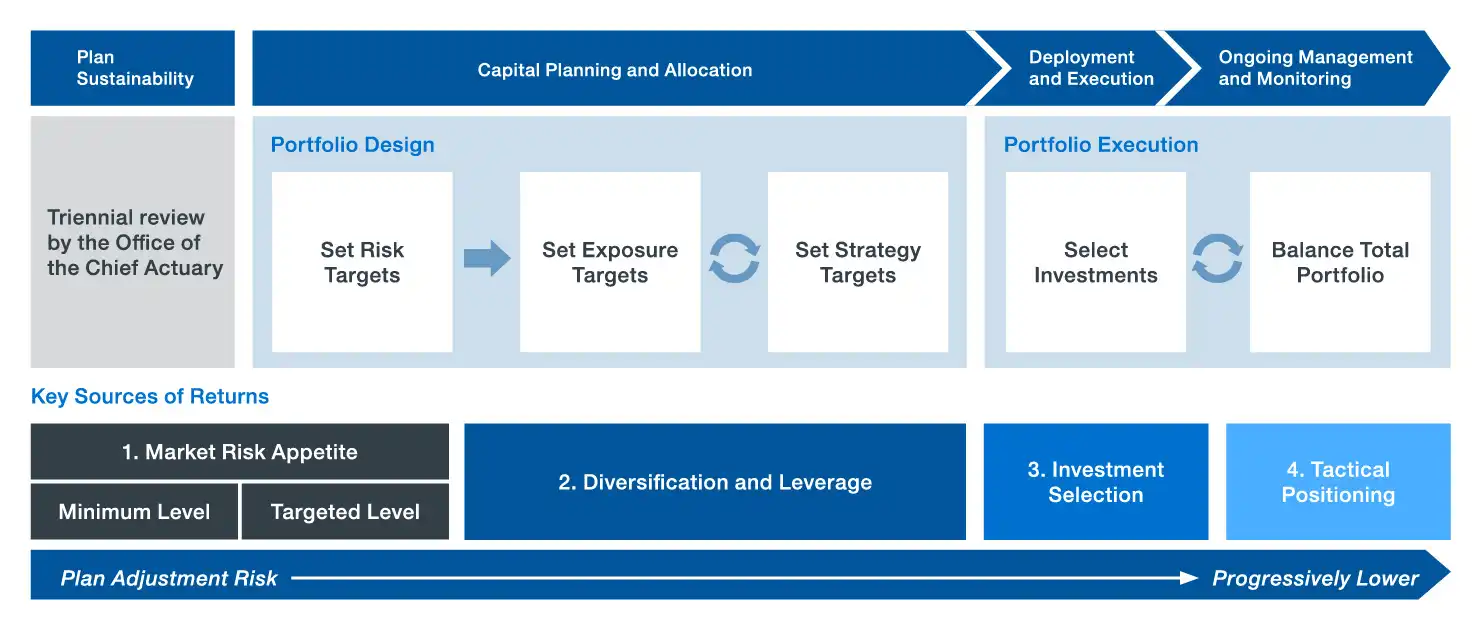
Market risk appetite
The foundation of investment strategy for any portfolio is a prudent and appropriate overall market risk appetite. Following each triennial review conducted by the Office of the Chief Actuary (OCA), CPP Investments uses information contained in the OCA’s Actuarial Report and our own return expectations to estimate the minimum amount of market risk required to be taken by the Fund to help maintain the long-term sustainability of the base and additional CPP.
We represent this minimum level of market risk as a portfolio that includes approximately 50% global public equities and 50% Canadian government bonds for the base CPP. For the additional CPP, we estimate this to be 40% global public equities and 60% Canadian government bonds.
However, we do not believe that achieving these minimum returns will be sufficient to deliver on our full legislative mandate, in particular maximizing returns without undue risk of loss. We actively manage the Fund and pursue additional sources of returns, which includes choosing to target a higher level of market risk.
Diversification and leverage
Diversification is an established way to mitigate the impact of market downturns and enhance long-term returns without having to increase the amount of market risk we take on. Through the use of leverage, we are able to construct a portfolio that is broadly diversified across major asset classes and their underlying return/risk drivers at our targeted level of market risk. This allows us to deliver more consistent returns with greater resilience through market cycles compared to a portfolio that is only exposed to global public equities and Canadian government bonds.
Learn more about our approach to diversification.
Investment selection
Investment selection refers to how we access, select, weight, buy, re-weight and sell specific securities within a particular strategy.
Seeking to outperform a market index through active investment selection requires both covering costs and achieving better returns than the market index. As markets mature, they become more efficient and more difficult to outperform. Over any given period, there will be both winning and losing active managers in a market, with wide variation between their returns. That is why successful investment selection requires employing skilled people.
Several of our comparative advantages increase the long-term likelihood of investment selection success. We regularly review the underlying performance for all investment strategies. We evaluate to ensure each strategy remains likely to deliver meaningful value-add returns beyond that of a simple lower cost passive alternative, and worthwhile given the additional risks associated with it, including the risk of underperformance relative to the passive alternative. If our conclusion changes, we adjust or curtail the strategies concerned.
While seeking to deliver targeted exposures over time, our active investment groups will only make an investment when there is a sufficient prospect of earning an appropriate risk-adjusted return. We never make an active investment simply because it fills a gap in a particular asset class, exposure, sector and/or geography. Rather, this is done through our balancing strategies, which are highly scalable and can be managed at lower cost.
The balancing process is designed to maintain our overall exposures sufficiently close to their targets at all times. Each day, the process starts with a daily aggregation of the Fund’s ever-moving risk, factor, currency, geographic and sector exposures. When our total exposures have diverged too far from their intended targets, or if our total market risk varies unduly from its target, we execute trades within the balancing portfolio to bring our exposures back into line.
Tactical positioning
Tactical positioning is a deliberate, meaningful but temporary shift of asset allocations and/or exposures away from the portfolio’s established targets. We may take tactical positions by exploiting gaps between current market prices and long-term fundamental values.
We may do this to seek incremental returns, to protect assets against potential losses or to preserve liquidity under stressed market conditions. It can take place at the total portfolio level or within a specific asset class or strategy. We do not engage in short-term market timing. However, we do review market conditions and prospects and maintain a specialist group dedicated to analyzing short- to-medium-term market conditions, risks and opportunities.
CPP Investments’ tax strategy is consistent with our mandate and with CPP’s status as Canada’s national pension plan. It is one of a number of considerations we take into account as part of our investment process. Our tax strategy is best considered in the context of how CPP’s 22 million Canadian contributors and beneficiaries are taxed on their CPP income.
CPP Investments is a global investment organization working to help ensure that the Canada Pension Plan (CPP) is there for generations. We do this by investing the funds of the CPP on behalf of its 22 million contributors and beneficiaries. We are guided by our singular mandate to maximize returns without undue risk of loss, taking into account the factors that may affect the funding of the CPP. Our investment strategy is designed to capitalize on our comparative advantages while ensuring we maintain our commitment to responsible investing.
Our investment strategy is structured to be resilient in the face of wide-ranging market and economic conditions and covers all major asset classes, monitors significant risk factors and encompasses multiple distinct investment strategies.
With this approach we are able to achieve the right balance of risk and returns while seeking to add additional value through active management. Our goal is to achieve sustainable returns over the long term for the benefit of Canadians.
As a long-term global investor, CPP Investments sees value in stable and predictable tax regimes. CPP Investments has actively supported the work of the Organisation for Economic Co-operation and Development (OECD) on the Base Erosion Profit Shifting project and understands the need for governments to address inappropriate tax practices. We engage with, and constructively contribute to, public consultation by tax authorities and policy makers to ensure our perspective is understood, in line with our mandate to maximise returns without undue risk of loss.
Tax strategy
CPP Investments’ tax strategy is consistent with our mandate and with CPP’s status as Canada’s national pension plan and it is one of a number of considerations we take into account as part of our investment process. Our tax strategy is best considered in the context of how CPP’s 22 million Canadian contributors and beneficiaries are taxed on their CPP income.
For sound public policy purposes, income earned by CPP Investments and its subsidiaries is exempt from tax in Canada. This enables investment income to grow tax free in Canada during the investment period, and CPP beneficiaries are then taxed on receipt of their pension based on their tax rate at that time. This is similar to the treatment of Canadian registered retirement savings plans.
To ensure we create a well-diversified investment portfolio, we invest globally across a wide range of asset classes and more than 85% of our assets are invested outside Canada. As a result, CPP Investments is subject to the tax laws of the countries where we invest. We honour our tax obligations around the world and pay taxes due on the income earned in those countries. Various types of taxes are also paid by the companies in our investment portfolio, as determined by the tax rules applicable in the jurisdictions in which those companies carry out their business activities.
To help ensure that our 22 million Canadian contributors and beneficiaries do not pay tax twice on income earned by CPP Investments, we employ judicious and prudent investment structures designed to maximize the after-tax investment returns available to CPP contributors and beneficiaries.
Risk management and governance
The foundation of our mandate and resulting investment strategy is to ensure prudent and appropriate risk management structures and processes are in place. This includes factoring tax risk directly into how we make investments.
CPP Investments’ Board has oversight of risk management, including tax risk. To that end, the Board, through its various committees and processes, reviews internal controls and systems designed to address key risks for the Fund, including tax risk.
At the management level, CPP Investments’ Chief Financial Officer (CFO) is responsible for CPP Investments’ tax strategy. Day to day management of tax risk sits with the Head of Tax who periodically reports to the Audit Committee.
As with any other risk, our aim is to mitigate tax risk, taking account of our investment mandate, through adherence to the controls and procedures embedded in our internal policies. CPP Investments considers tax risks in terms of:
- Technical risk – the risk that our tax position is successfully challenged in whole or part by a tax authority due to uncertainties under relevant tax laws or regulations.
- Operational risk – the risk that certain actions / operations do not happen as expected and the tax outcome is different to our expectation.
- Regulatory (change of law risk) – the risk that our expected tax cost changes over time due to changes in tax law.
For each of these tax risks we have controls and procedures in place to mitigate potential financial and/or reputational implications, including when and how particular tax risks are escalated in the organisation.
The Head of Tax is supported by our in-house team of tax professionals located in our offices around the world. This team comprises appropriately qualified and experienced professionals, with specific tax responsibilities and accountabilities. They use their experience and judgement to assess the tax risk, working with our investment departments and core services departments to manage the risks of our investments. We supplement our in-house tax expertise through the use of local tax advisors to understand our obligations and associated tax risks in a specific jurisdiction.
Given the complex nature of tax legislation globally, we take professional advice to help us assess and manage tax risk and support our tax positions. We do not place any reliance on a low risk of detection of any position taken. When we encounter areas of tax law which are unclear, we seek to take an approach which is consistent with well-established government policy and market practices and may seek clearances from taxation authorities.
The global tax environment is constantly changing. CPP Investments’ in-house tax team, with the assistance of our local tax advisors as required, regularly monitor changes of tax law to understand potential impacts and to remain in compliance with tax laws around the world. When we engage with tax authorities worldwide, we are transparent and disclose relevant facts regarding our investments and operations to the tax authorities.
The content on this webpage is regarded as complying with the duty under Schedule 19 of the UK Finance Act 2016 on behalf of all relevant entities within the CPPIB group for the year from 1 April 2023 to 31 March 2024.
In appropriate circumstances, we use board nomination rights to responsibly preserve and enhance the long-term value of our investments.
CPP Investments regularly negotiates governance rights in conjunction with its investments. This includes the right to nominate directors to the boards of those investments (referred to as portfolio companies) and shareholder reserve matters. Although CPP Investments does not make management-level decisions or act as management for its portfolio companies, we employ these governance rights to allow for constructive engagement with, oversight of, and support for management teams. These governance rights are key to creating and preserving the long-term value of our investments.
Where CPP Investments negotiates board nomination rights, we take a comprehensive approach to the selection of internal directors (CPP Investments’ employees) and external directors (third-party non-executive directors, or NEDs) to ensure that each director is chosen based on skills, experiences, and qualities that add value to that board and portfolio company. The approach also considers governance best practices on an ongoing basis, including thorough training and engagement, ensuring a clear understanding of director duties, and monitoring.
Nominating directors to portfolio company boards
In appropriate circumstances, we use board nomination rights to responsibly preserve and enhance the long-term value of our investments. In all cases in which we have nomination rights, CPP Investments nominates directors, whether internal or external, that meet the requirements needed for the board. We believe that third-party NEDs enhance the level and diversity of experience around the board table of our portfolio companies.
CPP Investments’ follows a rigorous process for nominating directors. That process includes, among other things:
- A rigorous, skill matrix-based approach to selecting directors. Each director – internal and external – is chosen based on skills, diversity of experiences, and qualities, that contribute to the most important strategic questions and challenges that the particular portfolio company is likely to face. We also seek to ensure that prospective directors have the capacity to dedicate the time required to the role, given the significant workload that directors typically take on.
- To help ensure CPP Investments nominates high-quality external directors, we typically use external search firms to help find potential candidates.
- All nominations require the approval of CPP Investments’ senior management, as well as consultation with the Portfolio Value Creation group.
CPP Investments employees acting as directors for portfolio companies are not compensated in their capacity as directors and do not receive standalone compensation for their service.
Director training program
CPP Investments runs a robust training program for nominees to portfolio company boards. Among other things, it includes the following:
- A mandatory training course, based on CPP Investments’ Board Guidelines and developed in partnership with external governance experts, offered several times a year to internal directors. This course provides guidance on critical board issues such as ensuring board effectiveness, expectations regarding director behaviour, understanding fiduciary duties owed to portfolio companies, and managing conflicts of interest.
- An ongoing director training series that includes training modules on topics such as: creating a culture of inclusion and diversity, building high-performing management teams, navigating difficult stakeholder conversations, addressing disruptive threats, and board oversight of management compensation. These modules are offered to internal and external directors. They are regularly updated, with new modules offered regularly.
- The opportunity to attend formal external training programs such as those offered by the Institute of Corporate Directors; and internal resources, guidelines and ongoing internal support to ensure directors are well-equipped to discharge their duties.
In addition, CPP Investments runs a continuous NED engagement series: an ongoing set of virtual and in-person meetings and communications that allow us to share information and best practices with our nominee directors, align on key issues, and learn from one another.
Duties of directors
CPP Investments supports and respects the division of authority and responsibilities among the triad of interests that is the core of good governance – owners, directors and managers. Appreciating the roles everyone plays is critical:
- Shareholders own the company and elect the directors to be stewards of the company;
- Boards of directors are responsible for the overall governance of the company, typically focusing on strategy, monitoring its implementation, appointing the CEO and overseeing management;
- Management is responsible for developing and implementing the company’s strategy and for running its operations; and
- Management is accountable to the board and the board carries out its duties in the best interests of the company.
Ongoing monitoring
CPP Investments has established internal accountabilities to monitor the performance of our nominees as well as the application of governance best practices on an ongoing basis.
2025 Annual Report
We continue to deliver solid performance for the long term, helping to grow the Fund and build a foundation for Canadians’ retirement security.
